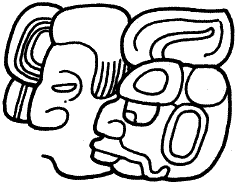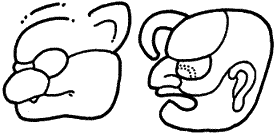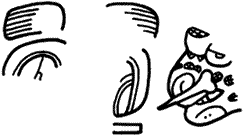Simon Martin
|
An extract from "Tikal's Middle Classic: Kings, Queens and Consorts," a paper presented at 'Lindafest', a gathering of friends and colleagues of Linda Schele at University of Texas at Austin, January 24, 1998.
Tikal's Middle Classic Period, less a chronological span than a term of convenience, describes the first fifty years or so of its sixth-century. It provides a sizable group of monuments for study, but their generally poor condition has long thwarted any clear view of their political message. The deliberate damage and displacement shown by quite a number have led most writers to see dynastic disturbance of one form or another. A re-examination of these monuments allows us to cast new light on this era, identifying some its key actors and underlying political context. At this point I need to thank Christopher Jones and the University Museum, University of Pennsylvania, for providing such generous access to the Tikal archive, without which this research would not have been possible.
One of the most shadowy but interesting Middle Classic characters is the so-called 'Woman/Lady of Tikal'. She was originally identified on Stela 23, a much-damaged upper fragment found in a residential compound some distance from the Great Plaza. The stone had been dragged there and re-erected as much as three centuries after its carving.

Portrait of the Lady of Tikal on Stela 23. The portrait is badly battered, but shows a recognizably female figure. The monument's rear text refers to important events in her life. She was born in AD 504 and acceded to the rank of ahaw in AD 511, a queen at the tender age of six years old. Clearly, complex dynastic maneuverings lie behind this unprecedented event. Maya queenships only came into being in the direst of circumstances, after the failure of the male line and when collapse of the dynasty was imminent. Their rule was considered so unorthodox that it required careful explanation, not to say mythological 'spin'.
As Linda Schele and David Friedel have shown at Palenque, Hanab Pakal and his son Kan Balam went to elaborate lengths to justify the rule of Lady Sak K'uk', Hanab Pakal's mother, and state her suitability as a conduit for the royal bloodline. To do this they compared her with a founding goddess, the First Mother, even ascribing her this name in her accession statement to make the association explicit. Such seems to be the case with the Lady of Tikal, since her name on Stela 23 closely resembles that of a patron goddess listed on another Tikal monument, Stela 26.

Name on Stela 23, C4. 
Name of a Tikal goddess, Stela 26, zB9. She was clearly the pawn of older relatives and guardians; do we receive any sight of these people? How long did she did she reign and what was her real name? These questions can now be answered, at least in part.
Stela 6 was erected just three years after her accession to mark the 9.4.0.0.0 Period Ending of AD 514. Even though the monument is badly smashed and its text eroded, it preserves the name phrase of its presiding ruler.

New drawing of Stela 6 side. One side fragment includes the deity name 'Hand-Nah-GI' which, for reasons that are still unclear, often appears in the names of prominent women. A few glyphs further down we see the nabal k'inich epithet, which usually follows the names of Tikal rulers. Between these two we should find the personal name of the monarch and, although damaged, a female head joined to an early form of the syllabic sign yo, can be made out (above another illegible sign). 
The personal name of the Lady of Tikal. Stela 6, By3. There is every reason to believe that this is our Lady of Tikal using her own name. The portrait on Stela 6 is so fragmentary that it provides no clear pointer to the gender of the figure. Yet an incised glyph close the figure's head carries a female prefix and might well suggest that the queen is depicted again. With this name in mind, it is possible to identify her on Tikal's next monument, Stela 12 from AD 527. 
The personal name of the Lady of Tikal. Stela 12, B6. Although the protagonist here has been dubbed Curl Head, this glyph proves simply to be one of her other names or titles, and later in the same text we find the female head with the yo sign seen on Stela 6. In this case the damaged portion is a portrait head, probably that of the Sun God. We know now that the Lady of Tikal reigned for at least 16 years - she was a young woman of 23 years when Stela 12 was erected. But the same monument provides evidence that she did not rule alone. Its front face carries the portrait of a male figure, his name appearing on a side text as the stela's 'owner'. It consists of the 'Batab' title read kalomte' followed by a jaguar head with a prominent ornament piecing its nose, with a large 'square' eye and a second, human ear. 
The 19th King of Tikal, Kalomte' Balam. Stela 12, D4-5. While this could be a single sign, it is more likely to be a conflation of two distinct heads. For want of a proper translation I shall call him Kalomte' 'Balam'. He carries a variant form of the 'successor title', marking him as 19th in the Tikal line. But was this one of the people manipulating her rule - a husband or guardian - or instead a young son? On Stela 12 they take distinct, but complementary roles: the key calendrical ceremonies are performed by the queen, while the stela itself is dedicated to the king. This is reminiscent of the situation some two centuries later at Naranjo, where Lady Six Sky and her son K'ak' Tiliw Chan Chaak (a.k.a. Smoking Squirrel) share royal performances and each receive their own monumental portraits.
Kalomte' Balam proves to be an important figure who was also the protagonist of Stela 10, Stela 12's twin. Damage to this stone has always barred a complete understanding of its chronology, but one of its most important topics is a war in AD 486 and an attack against the city of Masul, one of the earliest war events described in a Maya text. Kalomte' Balam's name appears on the left side in connection with a captive-taking - his square-eyed jaguar head on Stela 12 here separated into two signs.

The 19th King of Tikal, Kalomte' Balam. Stela 10, C7-D7. Though it is badly ruined, he also seems to appear on Stela 25, dedicated in AD 517. Yet another instance of his name appears on a fragmentary bowl from Problematic Deposit 22 of the Tikal North Acropolis, now labeled MT.9. Again a kalomte' title is linked to a jaguar head with a pieced nose, here clearly a bone or stingray spine. 
The 19th King of Tikal, Kalomte' Balam. MT.9. The war date on Stela 10, most likely during the reign of K'an Boar, is particularly interesting. It could suggest that Kalomte' Balam was a one-time war captain who became co-ruler with Lady of Tikal quite late in life. This would obviously preclude him being the young son of the queen, and must instead have been her guardian or consort. What are we to make of Tikal's Middle Classic in light of these finds? We can now date the beginning of its dynastic difficulties to a breakdown in the male line at the beginning of the sixth century. In response to this the Tikal nobility, or a faction of it, set a six-year-old girl in office. We can assume that she represented the legitimate bloodline, probably as the daughter of the preceding king Jaguar Paw II (sadly, the name of her father, once stated on Stela 23, is now missing). It is likely that from the outset Kalomte' Balam was the major figure behind her rule, styling himself as the '19th successor' though, in fact, he seems to have been a military man whose claims to the throne were more distant than those of the queen. |